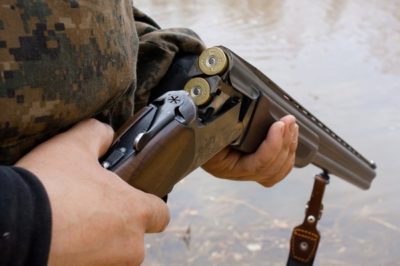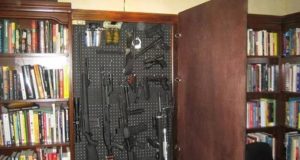 Shotguns have long been considered the king of the home defense realm, and only recently have the carbine and pistol stepped up to challenge this. That’s a different article for a different time, though. Here, we are going to focus on the shotgun for home defense and property defense.
Shotguns have long been considered the king of the home defense realm, and only recently have the carbine and pistol stepped up to challenge this. That’s a different article for a different time, though. Here, we are going to focus on the shotgun for home defense and property defense.
In my opinion, a shotgun is a thinking man’s weapon. It’s incredibly capable and adaptable, and has more applications than any other weapon. The shotgun can be adapted to your situation and your environment, with specific loads tailored for your situation. The shotgun is capable of taking all sizes of game in North America. It is capable of killing birds to bears — and everything in between – and is especially useful against two-legged vermin.
Now, we are strictly talking regular power loads, with a preference being for 2 and 3/4 over 3. Three inches is more powerful, but produces more recoil. Three inch magnum loads are capable for hunting rounds, but not necessary for self-defense.
Let’s look at the three loads that make up the majority of shotgun ammunition: buckshot, birdshot and slugs.
Birdshot for self-defense seems awesome, with little to no penetration of walls, and you’re protected from the dreaded over-penetration right? Well, not a single birdshot load penetrates the required 12 inches to produce a reliable killing shot. Let’s also remember that Dick Cheney accidentally shot his friend, a man well into the middle of his life, in the face with birdshot and the man made a full recovery.
How to hide your guns, and other off-grid caches…
At the distance where you’re poking them with your shotgun I’m sure it’s plenty fatal, but further than that and I just find it to be less and less likely that’ll you’ll stop a threat effectively. I also wouldn’t want to be that close to a bad guy.
Why use an inferior load made for squirrels, birds and clay pigeons?
Now, of course, you have slugs, and slugs can be used to reach out a little further than standard buckshot — roughly about 100 yards with a bead sight. Slugs can be devastating and are an option if the fight moves its way outside the home, or if you keep a shotgun for your trunk gun. Slugs are always good to have, but I personally don’t like them as an inside-the-home defense load.
Slugs can really over-penetrate. Plus, why use a slug? After all, a shotgun is a shotgun because it shoots a load of shot. A slug gun is kind of a big, low capacity rifle.
Story continues below video
Buckshot is my choice for home defense. Buckshot consistently penetrates to 12 inches and is capable of producing devastating wounds.
So penetration is covered, but what about shot placement? Well, per-shot the shotgun provides multiple projectiles, creating multiple wound paths, and therefore increasing the likelihood of placing an effective shot. Even if nothing vital is hit and a fatal wound isn’t inflicted, you’ll have an attacker full of pieces of lead, creating multiple wound channels throughout his torso – not only a very painful series of wounds but a debilitating effect on the body.
Ultimate Tactical Self-Defense And Hunting Weapon That Doesn’t Require A Firearms License!
That being said, never assume your shotgun is a magic death ray. It’s a great weapon, a devastating weapon, but it’s not a Boba Fett disintegrator. Follow through and do not assume the fight is over until it’s over.
So buckshot is a good inside-the-home load; we’ve established that. So what buckshot should we use? Conventional wisdom says double ought, right? Perhaps 8 33 caliber pellets, which are more than capable of stopping a bad guy, right? The police and military used double ought so it has to have merit, but is it the best load?
There are loads like Winchester PDX that combine slugs and buckshot, which is supposed to be designed for fighting, so that could be a choice. Sure, but it’s basically a slug backed up by three rounds of buckshot.
So triple ought? Nah. I think No. 1 buckshot is the most efficient of loads for self-defense. No 1 is a favorite of old school guys with old fixed choke shotguns that used No. 1 as a hunting load. It my favorite, and here is why.
First off, the rounds are slightly smaller than the double ought; therefore, you reduce over-penetration by a degree — not enough to discount it, but still just a bit.
Secondly, it’s efficient. 8 33 caliber pellets or 16 30 caliber pellets? Hardly a tradeoff for double the payload.
Speaking of efficiency, let’s do some simple math. A load of 8 pellets of double ought buck is about 430 grains. A load of No. 1 buckshot is 640 grains. This may vary a bit by company and load, but No. 1 will always be considerably heavier. I’m not trying to assume that a load of buckshot is going to be the equivalent of a 640 grain solid projectile. I’m just trying to give an idea of the efficiency of No. 1 buckshot as well as giving you a good idea of the amount of lead you’re fighting with.
This isn’t to say 00 buckshot isn’t a good fighting round, but it’s not the best. No. 1 costs the same as double, but it can be harder to find.
So you’re not wrong with 00; you are just less right, but you’re way better off than people who use birdshot.
Do you agree or disagree? Tell us in the section below:
 Off The Grid News Better Ideas For Off The Grid Living
Off The Grid News Better Ideas For Off The Grid Living




